- Lot
- Information
by Enya Li
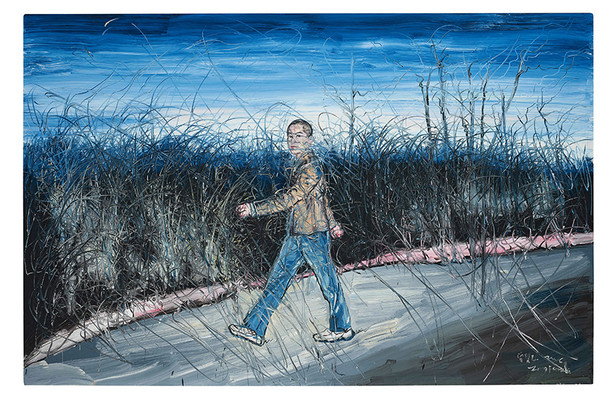
Zeng Fanzhi
Self-Portrait (Stroller)
Painted in 2006
Oil on canvas
215 × 330.5 cm
In October 2013, in the centre of the art world, the works of Zeng Fanzhi were displayed at the City of Paris Museum of Modern Art as part of a major retrospective exhibition of the artist’s life, making him the first living Chinese artist to receive such an opportunity. With that, Zeng Fanzhi received acknowledgement from the most renowned art gallery in the West. This was not only a milestone in his artistic career; it also signified how quickly Chinese contemporary art progressed in the past 30 years.
From the beginning of the new millennium, a preliminary exploration of Abstract Expressionism led him to the most important stylistic turning point of his creative career. In the spring of 2001, the artist injured his right hand and decided to try using his left to paint. Out of this, he unexpectedly developed a new mode of artistic expression — so-called “chaotic” brushstrokes. He would rapidly paint overlaying lines on the canvas, and this constructed a “disorganised grass scene”. The technique redefined his creative style, which later expanded to portraits that changed the mode of conventional portraiture and gave rise to Zeng’s brilliant Chaotic Pen series.
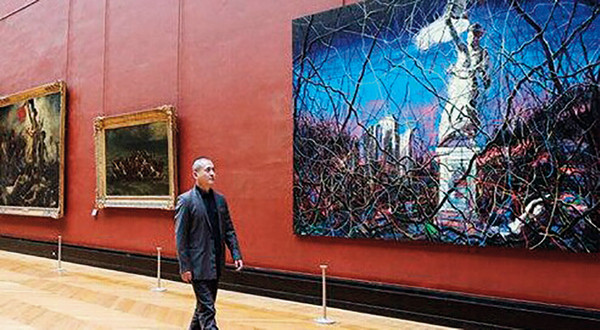
Zeng Fanzhi walks through his exhibition at Louvre, France in 2014.
Self-Portrait (Stroller), created in 2006, is one of the works presented here at this auction. As can be inferred by the name, the artist took this unique way of painting to depict himself and instill the piece with profound, insightful meaning, making it a testimony to how important this turning point and breakthrough indeed were for Zeng during this period.
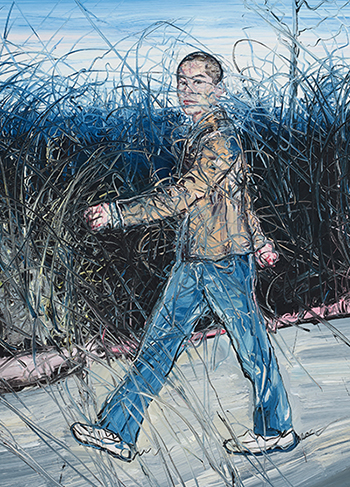
Part of Self-Portrait (Stroller) by Zeng Fanzhi
Abstract Lines: from Depictions of Reality to Freehand Expression
It can be seen here that the texture of the brush itself and the gradual merging between white and blue depict a myriad of changes in the sky. In the middle of the image, the artist’s quick brush strokes left wild, rushed lines one after the other as they crisscross in disorder in various forms such as straight lines, curves, and even circles. Although these lines convey an overall disarray, each and every line is subtly different and unique, with not a single one repeated. In the untidy strokes, it is not difficult to see an association with Chinese cursive script, Van Gogh’s golden and circular wheat fields, Pollock’s unconscious expression of art via the spilling and splashing of paint, or Kiefer’s “burnt-out aesthetics” in the form of tangled and withered plants.
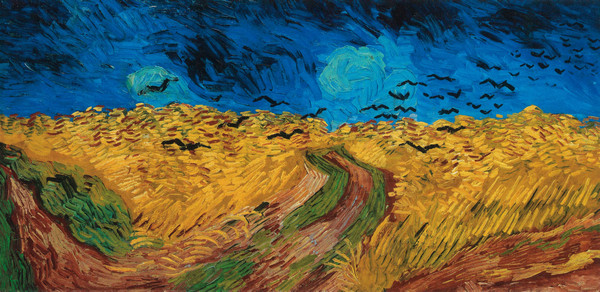
Van Gogh
Wheatfield with Crows
Painted in 1890
50.5×103 cm
The thick, chaotic growth of grass, which became a recurring symbol after Zeng’s Mask series, represents the various practical problems that people must overcome throughout the journey of life. Under the clumps of grass, a fleshy pink runs across the entirety of the painting, superimposed upon the contour of the road. This expands the meaning conveyed by Zeng Fanzhi’s characteristic “flesh-coloured people”: “Roads are for those making their way out.”
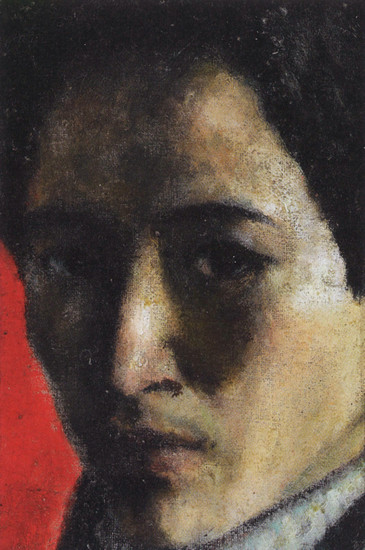
Zeng Fanzhi
Self-portrait
Painted in 1986
18×12 cm
Reflecting on the Present as a Leader for the Era:
A Self-portrait of One Strolling
Zeng Fanzhi was deeply aware that success could make someone self-satisfied and that self-satisfaction would make someone insensitive, unable to correctly know the self. This is why he, at different periods, would create self-portraits and use them to get a good look at himself. Among his works, this type of self-portrait is quite rare, and as such, each is clearly especially valuable.
Most self-portraits depict the artist sitting; Self-Portrait (Stroller), on the other hand, shows the highly uncommon image of the painter walking. Here, the “self” is at the centre, looking directly at the viewer without a hint of shyness or a desire to escape. The subject’s eyes are both bright and spirited, and his glance reveals resolve and tranquility. His clothing is neat and fashionable, with a natural and self-confident style. With a leader’s poise, he strides ahead, his right leg pacing forward, his left arm swinging ahead, symbols of an artist who not only accepts his present situation but also looks forward to a brighter future.
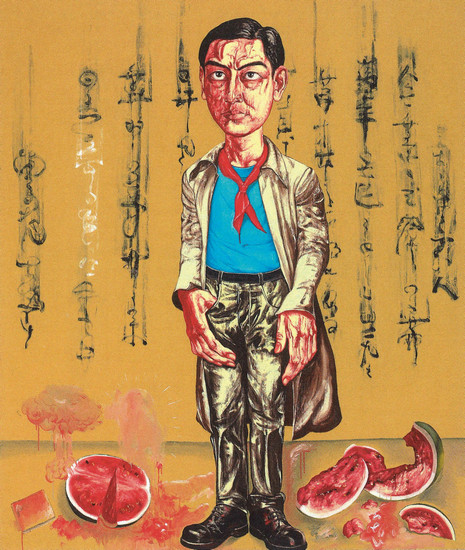
Zeng Fanzhi
Self-portrait
Painted in 1996
200×169 cm
The work was created in 2006, when China’s contemporary art market was developing explosively and Zeng Fanzhi’s artworks were yielding excellent results. China was in a “pre-Olympic” period, with rapid economic and infrastructural development taking place as far as the eye could see. This is why the painting shows the artist full of self-confidence, and the image of a person with clear aims not only represented the artist himself, but even more the devoted efforts of all who called themselves Chinese. In Self-Portrait (Stroller), he did not put on a mask for people but deliberately chose to make a rare full-length portrait, creating a grand narrative as in Courbet’s portrait The Meeting and thereby conveying a historical sense of mission. The artist externalised his inner reflection and — through affirmation of his own situation — paid tribute to the constantly advancing Chinese people and nation, the significance expressed in the work bearing a certain resemblance to Chairman Mao Goes to Anyuan.
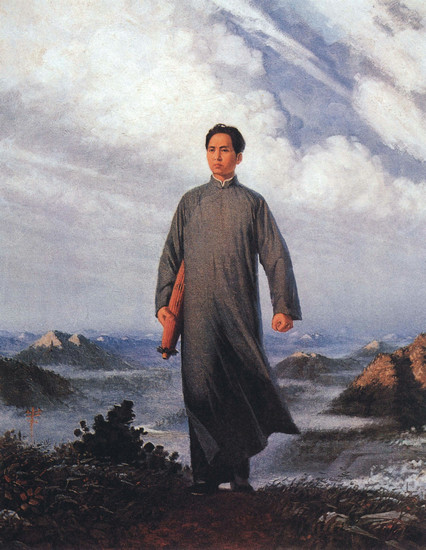
Liu Chunhua
Chairman Mao in Anyuan
Painted in 1967
220×180 cm
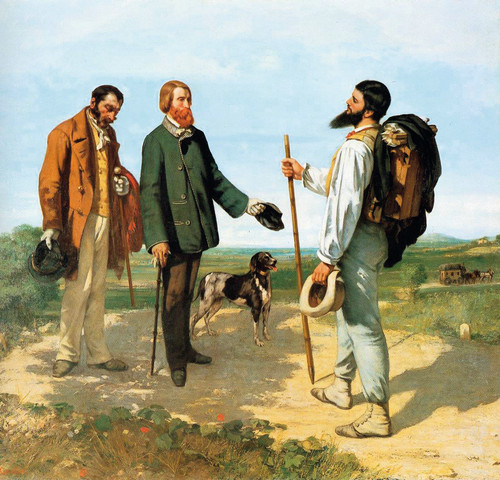
Courbet
The Meeting,Bonjour, Monsieur Courbet
Painted in 1854
129×149 cm